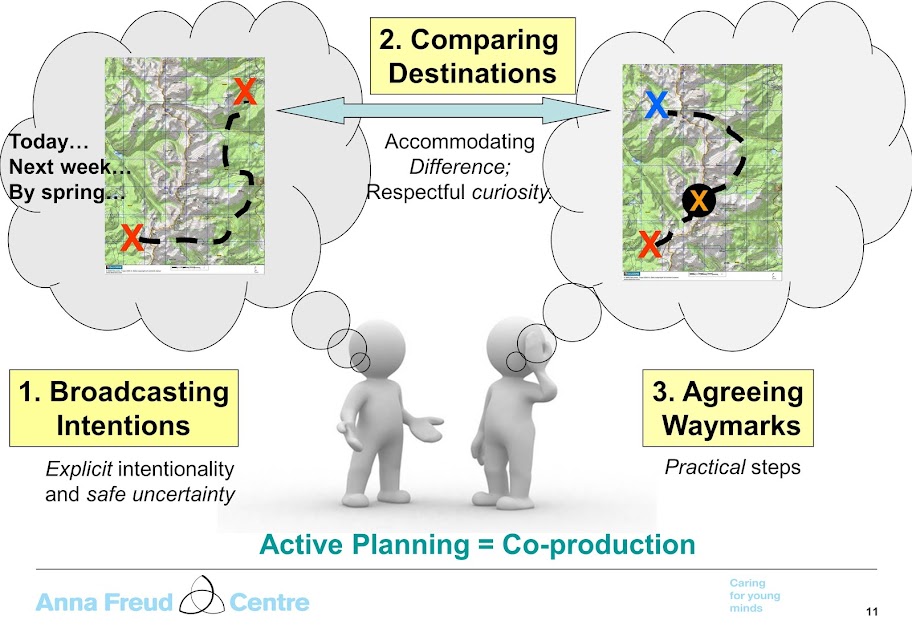10th November 2016
CONTENTS of this page:
1. Principles2. Practice
3. Tools
1. PRINCIPLES
(a) Balancing
- Critically Active Planning can be seen as a practical application of Holding the Balance from The Therapist's Mentalizing Stance, and to the wider notion of balancing between the Core Features of AMBIT
- An important part of it is about a team adopting a "style-of-working" that attempts to BALANCE three elements of the work:
| BALANCING |
1. Setting objectives and plans 2. Sustaining Sensitive attunement 3. Worker Broadcasting Intentions Balancing is necessarily a dynamic state Sometimes one or other element will be more dominant, but over time there is a balance. What is important is that the team does not allow the relationship between these to become RIGID or FIXED. |

| ACTIVITY | PURPOSE | RISK IF UNBALANCED | |
| 1. | Set objectives/plans (or Aims and Goals) | To support effective change (Governance) | Teleological thinking |
| 2. | Sustain Sensitive attunement (a.k.a. The Therapist's Mentalizing Stance) | To hold Engagement and improve Relationship to help | Pretend mode |
| 3. | Broadcasting Intentions | To elicit support (Scaffolding existing relationships) | Psychic equivalence |
Coda for the curious: This Holding the Balance between different functions is analogous to the interaction of the three main functional modules of mind-brain described in Johnson, Baron-Cohen et al (2005) emergence of the social brain network.
(b) A Team Culture of Planning
"Having a plan is better than 'winging it'!"| See the separate section on Developing a team culture of planning |
(c) Planning is NOT getting out of Responding!
| "Sometimes mentalizing means DOING the right thing!" |
(d) It's about Planning (a verb), not PLANS
| Map-reading, not Maps... |
An analogy:
In the days before Satellite Navigation, the map itself was important, but not as important as the skill of map-reading: the constant taking of bearings from the landscape, and triangulating these to check the true position on the map... allowing the adjustment of one's course; in wild country it is rare to travel from point A to point B "as the crow flies". Likewise, Active Planning facilitates the kind of strategic route-planning (taking the longer route, that avoids the swamp) that makes safe arrival at treatment goals more likely.
2. PRACTICE - the Active Planning Process
What follows are some simple steps that can help shape the actual process of coming to a Care Plan (see How to draw up a Care Plan for a stepwise guide to that specific task - this is the process that underlies it) in a way that holds to the principles of balance described in Active Planning in the team culture.
We do not presume that the actual steps in the process are very much different in practice from what goes on in effective Care Planning in many teams and treatment models. What we intend is that these steps are coherent with the rest of the AMBIT model, and are explicit rather than being carried out implicitly.
 |
The steps in this process are explained below, but it is important to emphasise that:
1.The journey is not necessarily a sequential one
2. The details will differ according to which of the Phases of AMBIT work you are currently in
 |
Steps in the Core process of Active Planning
Clicking this button will give you a drop-down list of the steps in
The steps in this Planning Process are unlikely to contradict existing best practice, and are as follows:
| OUR NAMES: | CONVENTIONAL DESCRIPTIONS: | |
| Taking Aim | = | Collaboratively noting the way things are (Assessment) and learning What's the problem? |
| Broadcasting Intentions | = | Using Mentalizing skills to build engagement and collaboration |
| Comparing Destinations | = | Collaboratively defining therapeutic direction (Aims and Goals); developing a Formulation and Treatment Aims |
| Agreeing Waymarks | = | Collaboratively developing a Care Plan that sets out the route ahead |
| Setting out together | = | Getting started on this specific planned work is part of the KeyWorker relationship |
| Taking Aim again | = | Reviewing, and sensitively/strategically adapting these plans |
| Finally, see also In my beginning is my end as one of the Engagement techniques that begins this process. |
3. Tools to help
- Teams may use tools as a part of regular practice to create structure for this process in face to face working.
- 1. Active Planning Map
- The Active Planning Map is a simple back-of-the-envelope tool (a simple adaptation of Maslow's HierarchyOfNeed) to help structure the interactions between worker and client.
- Some teams may primarily use this tool just as a training exercise to emphasise the principle of collaborative care planning, attunement, and adjustments to create Contingencies in what is offered.
- 2. Formulations and Communications
- Creating and communicating a clear (mentalized) narrative for how the difficulties arose, what maintains them, and what the aims in our work might be is critical
- See Formulation and Treatment Aims for advice on how to present and communicate this (an example of Broadcasting Intentions).